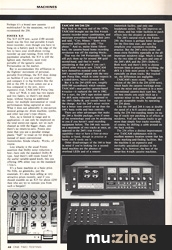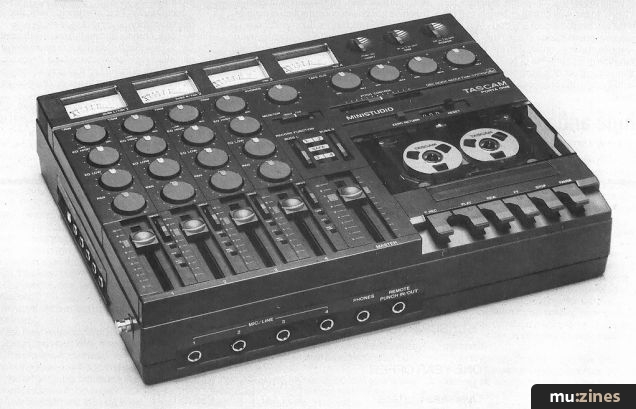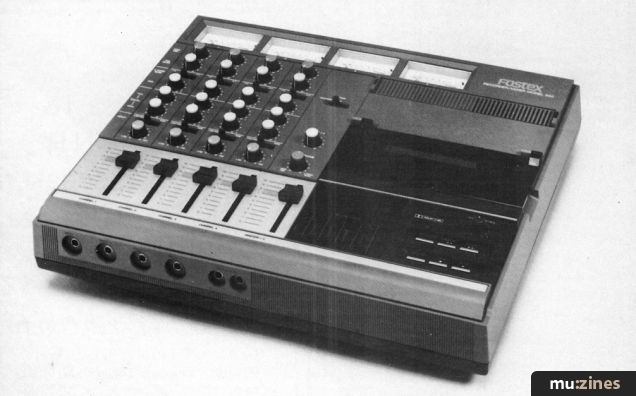Magazine Archive
Home -> Magazines -> Issues -> Articles in this issue -> View
Article Group: | |
Four-track Cassette Machines | |
Article from One Two Testing, January 1985 | |
a round-up from Aria, Clarion, Fostex, TASCAM and Yamaha. guides to nine popular cassette, four-track recorders
ARIA R504
The R504 (£543 new) is one of the mixer-less types of 4-track cassette recorders, with built-in switching for track-bouncing (in other words, no lead swapping as with TASCAM's similarly priced but far superior 234) and the outward appearance of a hi-fi cassette deck.
Its attractiveness is in its no-nonsense and relative no-frills approach to multitrack, and surprises no-one with its double-speed, pitch control, return-to-zero, mechanical counter, and pair of headphone sockets.
What it also has is a non-specified noise reduction circuit (ie not the accepted Dolby or dbx) and while this raises the eyebrow of unfamiliarity, it does in practice do the business, even if one needs a relatively higher level of signal whacking the VU needles than is usual with the more conventional circuits.
When it first appeared we liked the Aria for its workmanlike approach, even if our review sample had a noisy motor that irritated us no end. But price variations now make it no competition whatsoever for the TASCAM 234. You'll still get usable results from the 504 if you want a very simple notebook for musical ideas. But assuming that you want to spend your money in the most prudent fashion, this machine is out of the running today.
CLARION XD5/XA5

When the Clarion (£1597) was launched in '83, the ad campaign ran something like 'some recording systems stand on the sideboard, only one stands on its own two feet'.
Designed as a completely self contained, home recording system, the Clarion certainly stood, taking up a large slice of the carpet in the process. The do-everything approach was its appeal and its downfall. Within the two large, square, grey rack-mounted units were a 4-track cassette recorder with jack inputs, a set of level sliders and LED ladder meters. This XD5 chunk had a simple tape search and memory system plus Dolby B (not quite up to the 244's dbx and 250's Dolby C).
Down below in the matching XA5 section was another stereo cassette deck for mastering, four matching input channels this time with unadventurous bass and treble controls, a seven band stereo graphic that partly made up for the plain tone circuits plus a built in (rather hissy) echo unit and a drum machine with eight preset rhythms.
Unfortunately, none of these incorporated bonuses worked too well. The echo was noisy and short, the drum machine was less than thrilling in tone or rhythmic invention, and the wealth of level controls tended to be confusing duplications rather than useful additions.
Neither were the cassette decks themselves in league with the quality available from rival TEACs and Fostex. For the rock star who didn't fancy two miles of cable in the front room, the Clarion was a neat alternative, even carrying its own stereo, 30watt amp to power your monitors. But as the heart of a growing 4-track system where you were free to add better effects, drum boxes etc, it had some redundant and therefore expensive features.

FOSTEX 250
The 250 (£723 new, around £450 secondhand) was the second 4-track cassette mixer-recorder to appear, just pipping the TASCAM 244 to the post. It follows the now-established set-up for such machines, and allows you to route instrumental and vocal stuff through the integral mixer and on to one, several or all of the available four tape tracks. The mixer doubles as a routing box for the recording process and on mixdown (when you direct the final four recorded tracks back out of the machine through the mixer, with effects and eq added if you want, on to a standard stereo tape as your master). Yup, simple. Or not, as you choose.
The mixer of the 250 is more frugal and consequently a bit more straightforward than its rival, the TASCAM 244. But there are deficiencies in this frugality. For instance, the 250's tone controls are single bass and treble types, more akin to those on the original TASCAM 144 than the 244's dual-ganged frequency-sweep types.
But other than ergonomics there is little to choose between the TASCAM and the Fostex 4-track mixer-recorders. At present it's down to one of these two if you want a home-based machine of this self-contained sort, and the whole thing is much more likely to revolve around which one you can get hold of cheapest. More 244s seem to come on to the second-hand market than 250s. Bear in mind, too, that it's Fostex who are most likely to update or replace the 250. They've not introduced a new 4-track cassette-based product for some time, and there have been whispers from UK-based Fostex people about some kind of new multitrack product to come in 1985. Perhaps it's a brand new cassette multitracker? In the meantime, we'd still recommend the 250.
FOSTEX X15

The X15 (£279 new, about £180 secondhand) was the first real portable 4-track mixer-recorder, even though you have to bung on a battery pack to the edge of the box to have your stroll-about roving recorder up and running. Even with its pacemaker attached, the X15 is still the lightest and, therefore, most truly portable of the (generic sense) Portastudios on the market.
But to accommodate this affiliation to the Eighties' movement of personal, portable Everythings, the X15 does skimp on facilities if you are cruel (but fair) and compare it to big brothers like the 244 or the 250. It even comes out at a loss compared to the new, more expensive rival, TASCAM'S Porta One.
How so? Well, it only has two inputs and two faders, so there's not much hope, without buying an additional mixer, for multiple instrumental or vocal performances being captured at once. What it does suit admirably is one-person musical goings-on: drum machine, synths, and other last-year's-type objects.
Also, eq is limited in range and in application — it can only be employed on the total stereo-out signal, not on each channel as with the bigger chaps, and there's no return-to-zero. Fostex also insist that you use a peculiar orange plastic "ball" to tread on for drop-ins instead of more conventional footswitches. Kinda whacky. Works, of course.
Less whacky is the usual Fostex assertion that Dolby noise reduction is best — here only the standard Dolby-B type. And there's still room found for the useful variable-speed knob, this one offering 10% either way on the standard 1⅞ in/s.
It's a basic machine at a basic price. No frills, no gimmicks, just the essentials. It's also been selling at very attractive prices recently, and if you should stumble on an X15 for about £250 then who are we to restrain you from such a bargain?
TASCAM 144/244/234
Way back at the very end of the 1970s, TASCAM brought out the first 4-track cassette recorder-mixer combination, and musicians everywhere released their jaws and said, "Coo, blimey." Some even recovered sufficiently to add, "Yes please." And so, meine kleine führer-katz, the cassette-based home recording revolution was off the starting blocks.
That was the 144 Portastudio. You can still pick them up for around 300 quid second-hand, and they're worth considering at that price if you can't afford other 4-tracks new. TASCAM have themselves stymied some of the 144's second-hand appeal with the very new Porta One, which in some respects is a scaled-down, battery-powered 144.

But it is the 244 (£650 new, roughly £450-500 secondhand) which remains TASCAM's near-perfect cassette-based 4-tracker — it replaced the 144 in 1982.
For a start, the 244's tape section opted for dbx noise reduction as opposed to the 144's Dolby-B, and sounds better for the change. And the 244's mixer section has a better tone control set-up than the 144's basic treble and bass controls.
There are other advantages that make the 244 a flexible package, even if some of the terminology used can be perplexing to you if you haven't used recording equipment before. The 144 only records on a maximum of two tracks at once, as opposed to the 244's true 4-track capability — nice to have a four-at-once facility to hand, though in practice at home you'll rarely use it.
Other disadvantages of the 144 to bear in mind if you're looking for a secondhand machine are the absence of overload LEDs and of a remote-footswitch facility, and only one headphone socket. The 244 improves on all those, and has wider facilities to patch effects into the circuitry at mixdown.
The 244's natural rival is the Fostex 250: the Fostex is perhaps better designed for the first-time user, and opts for simplicity over customary recording practice. But the 244's extra knobs can mean extra flexibility especially at the all-important mixdown stage. Much is made by the two sides of the pros and cons of the 244's dbx and the 250's Dolby-C. Both work and there's little to choose between them in practice: if anything, the dbx is a little more prone to "breathe", especially on drum tracks. But tracked-up, the differences are negligible.

TASCAM's more recent "separate" version of the 244 is the 234 (£550 new), which hauls the cassette workings away from the mixer and presents it in a more conventional cassette-deck type box. So for best results you could hitch up a separate mixer to the 234, although you can get acceptable results by operating the 234 alone.
Like the 144 and 244 it runs at double the speed of a hi-fi cassette player, and using the 234 free-standing means no eq-ing of tracks nor patching in of effects at mixdown. Yod can bounce tracks to get more than simply four tracks recorded, of course, by shifting a cable around on the back sockets.
The 234 offers a distinct improvement over TASCAM stablemates with its excellent memory location system that has many marking-and-finding facilities. But the machine is an expensive and inevitably specialised product in the range. It is, however, the best of the mixer-less 4-track cassette machines.

TASCAM PORTA ONE
The Porta One (£430 new) is TASCAM's scaled-down, distinctly portable version of their ground-breaking 144, in that it records on a maximum of two tracks at a time, features simple two-way tone controls per channel, and has but one headphone socket. But its advantages are many, not least because of what we might call its carryaroundability. Clearly TASCAM had noticed the Fostex X15, and have improved upon that — even if it is on average sold for a hefty £150 more.
Its portability and ruggedness are good to have on board, even if the flush meters at the back can be difficult to see. Perhaps this is somewhere they should have copied the X15 and gone for bar-LEDs. Some people find meters easier to use — assuming they can see them easily, of course.
The Porta One is standard TASCAM fare in that it uses acceptable dbx noise reduction. The departure for TASCAM is the possibility of battery operation — but the batteries do at least sit inside the existing box, even though you'd probably decide to lash out on a power supply pretty soon after getting the Porta One. Nice to have the facility to record acoustic guitars in the park, however.
Some of the switching has been crammed into this small box and input switches' and track selector switches' status can be tricky to work out at a glance with TASCAM's chosen orange-marker indicators.
But in everyday use the Porta One is a doddle, and there are some good user-friendly touches like the positive-feeling rubber-capped mixer knobs. Normal tape speed also means some compatibility with ordinary stereo cassettes.
We'd have awarded the Porta One a virtually unconditional recommendation had it been some £75 cheaper, but even so it's still worthy of your attentions.
YAMAHA four-track system

Yamaha's MT44 is a free-standing 4-track cassette machine that is designed to fit into their rack of related gear (£747 new), including the MM30 mixer and PB44 patch bay. The tape machine appears to be based on Yamaha's longstanding domestic hi-fi division rather than the more recent innovations from TASCAM or Fostex. Thus it runs at normal (1⅞ in/s) tape speed, and has an appallingly involved method to switch from normal stereo to 4-track operation — what you have to do is stick a (hundreds supplied) silver sticky-backed rectangle to the rear of your cassette, which flips the machine into 4-track mode. Stupid. Ever seen a switch, Yamaha?
Advantages in compatibility with stereo cassettes are helped along with the inclusion of Dolby-B and Dolby-C. But you need another stereo cassette deck to master to anyway, so all this compatibility-with-stereo as an advantage is, how can we say, a skinny argument.
The whole rack-system works OK as a self-contained if bulky unit, although the MM30 mixer is a weak point. Its built-in echo doesn't sound too good, and the graphic eq for output tone control is something of a gimmick. Biggest drawback is the single treble tone control per channel. You'd soon find yourself needing a new mixer.
All these question marks about the Yamaha system point to a less than clear idea in the minds of the designers who put this system together. Certainly the system sounds OK once you've come to terms with its idosyncracies, but if you've ever used other 4-tracks you may well stumble for a while with the Yamaha. Better news is that you can pick the system up much more cheaply than our quoted recommended price. But overall it's a case of better luck next time.
More with this topic
Sampler Survey |
Ancient Cymbals |
 Buyer's Bible |
 Keyboard Guide |
Pianos |
The ARP Story - Keyboards |
Spring Reverb Roundup |
Synthesis on a Budget - The E&MM Buyers' Guide For Beginners |
Computer Checklist |
 Guitar Guide |
Sampling Keyboards |
 Equipment Guide |
Browse by Topic:
Buyer's Guide
Also featuring gear in this article
Aria R504 Four Track Cassette Deck
(12T Apr 84)
Fostex 250 - 4-track Recorder/Mixer
(EMM Dec 81)
Fostex X-15 Multitracker
(EMM May 83)
Fourplay - Four Track Cassettes
(12T Jun 84)
Getting the Best from Your Portastudio
(HSR Apr 84)
One Upmanship - Tascam Porta One
(ES Jan 85)
Reviews
(IM Dec 86)
Second-hand Section
(IM Dec 86)
Tascam 234 4-track
(12T Dec 83)
Tascam 234 Syncaset - Cassette Deck
(HSR Sep 83)
Tascam 244 - Portastudio Review
(EMM Aug 82)
Tascam 244 Portastudio
(MU Aug 82)
Tascam 244 Portastudio
(HSR Dec 83)
Tascam Porta One Ministudio
(HSR Dec 84)
Tascam's Porta-1
(IT Dec 84)
Teac 244 Portastudio, Fostex 250 Multitracker.
(12T Jan 83)
Teac 4-Track - Recording: Portastudio
(12T Nov 82)
The New Portastudio - Tascam Porta One 4-track
(12T Nov 84)
Browse category: Cassette 4-Track > Aria
Browse category: Cassette 4-Track > Clarion
Browse category: Cassette 4-Track > Fostex
Browse category: Cassette 4-Track > Teac
Browse category: Cassette 4-Track > Tascam
Browse category: Cassette 4-Track > Yamaha
Publisher: One Two Testing - IPC Magazines Ltd, Northern & Shell Ltd.
The current copyright owner/s of this content may differ from the originally published copyright notice.
More details on copyright ownership...
Bedroom Bouncedown - Home Recording
Topic:
Buyer's Guide
Gear in this article:
Cassette 4-Track > Aria > R504
Cassette 4-Track > Clarion > XD5
Cassette 4-Track > Fostex > 250 Multitracker
Cassette 4-Track > Fostex > X-15
Cassette 4-Track > Teac > 144
Cassette 4-Track > Tascam > 244
Cassette 4-Track > Tascam > 234 Syncaset
Cassette 4-Track > Tascam > Porta One
Cassette 4-Track > Yamaha > MT44
Gear Tags:
Feature by Tony Bacon
Help Support The Things You Love
mu:zines is the result of thousands of hours of effort, and will require many thousands more going forward to reach our goals of getting all this content online.
If you value this resource, you can support this project - it really helps!
Donations for April 2024
Issues donated this month: 0
New issues that have been donated or scanned for us this month.
Funds donated this month: £7.00
All donations and support are gratefully appreciated - thank you.
Magazines Needed - Can You Help?
Do you have any of these magazine issues?
If so, and you can donate, lend or scan them to help complete our archive, please get in touch via the Contribute page - thanks!



































